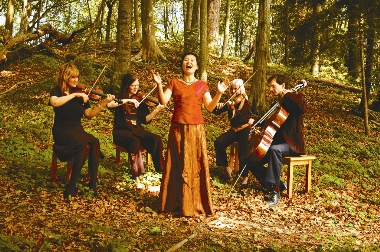|

Cao Zhen
A CHINESE music critic once said that it is not easy for a folk soprano to make a name for herself in China because the number of talents vastly outweighs the potential audience. Gong Linna is now challenging this.
Like Zhu Zheqin and Sa Dingding, who mix the opulent musical tradition of China with modern Western harmonies in an artful way, Gong’s folk also has a novel touch. But unlike Zhu and Sa, who label their folk as “world music,” Gong says her songs are “very Chinese.”
“My songs are inspired by ancient Chinese opera, folk and poetry,” said Gong at a news briefing Tuesday in Shenzhen. “And my goal is to explore new Chinese art music with my husband.”
Gong’s songs were all composed by her husband, Robert Zollitsch, a German expert of traditional Asian music. Growing up with Bavarian folk music, Zollitsch, also known as Lao Luo, studied traditional Chinese music and the Chinese zither guqin in Shanghai in 1993.
His compositions for traditional Chinese instruments make extensive use of harmonies, fusing together elements of different cultures, which leads to music that seems to be of traditional Chinese art style with a Western influence.
By using ancient Chinese poems as lyrics and a combination of yangqin, sheng, cello, ruan and accordion as instruments, Gong’s songs have been causing a sensation in Europe and Southeast Asia since 2002.
However, Gong was not well-known in China until February 2010, when a video of her singing an experimental song was popular online. Since the song has no lyrics, only some interjections, and Gong sings with exaggerated facial expression and body movements, netizens claimed it “an amazing song.”
“With no lyrics, the song has an ambiguous meaning. I didn’t write lyrics for the song because I want Linna to annotate it with her body,” said Zollitsch in an earlier interview.
Born in 1975 in Southwest China’s Guiyang City, Guizhou Province, Gong competed in numerous national singing contests in her childhood. She says her parents hoped her to live a simple life, climb gradually and finally get famous.
At 16, Gong began her studies at the Chinese Conservatory of Music. In addition to many other awards, she won the runner-up of the Chinese National Singing Contest’s folk category in 2000.
In 2002, she met Zollitsch, with whom she started a new artistic life. Experiments with world-music-fusion and avant-garde music as well as ethno-musical fieldwork marked the following years.
In 2003 Gong released her first album of “Five Elements.” On this album Gong gave her debut as a songwriter with beautiful lyrics. Her next album “Walking the Path of Life” published in 2005 finally set a landmark in new Chinese art music. Since 2006 Gong has been performing at many international festivals and in prestigious concert halls.
Optimistic and amiable, Gong says she still has a lot of dreams to fulfill. “I hope to star in an opera, playing all the roles and singing all the songs,” says Gong. She says she also hopes to collaborate with her husband to write a song using the bianzhong as the main instrument. Bianzhong is an ancient Chinese musical instrument consisting of a set of bronze bells, which have been dated at between 2,000 and 3,600 years old.
Gong will be in town next Thursday to present her new Chinese folk at Shenzhen Concert Hall in an evening titled “Free as a Bird.”
|

